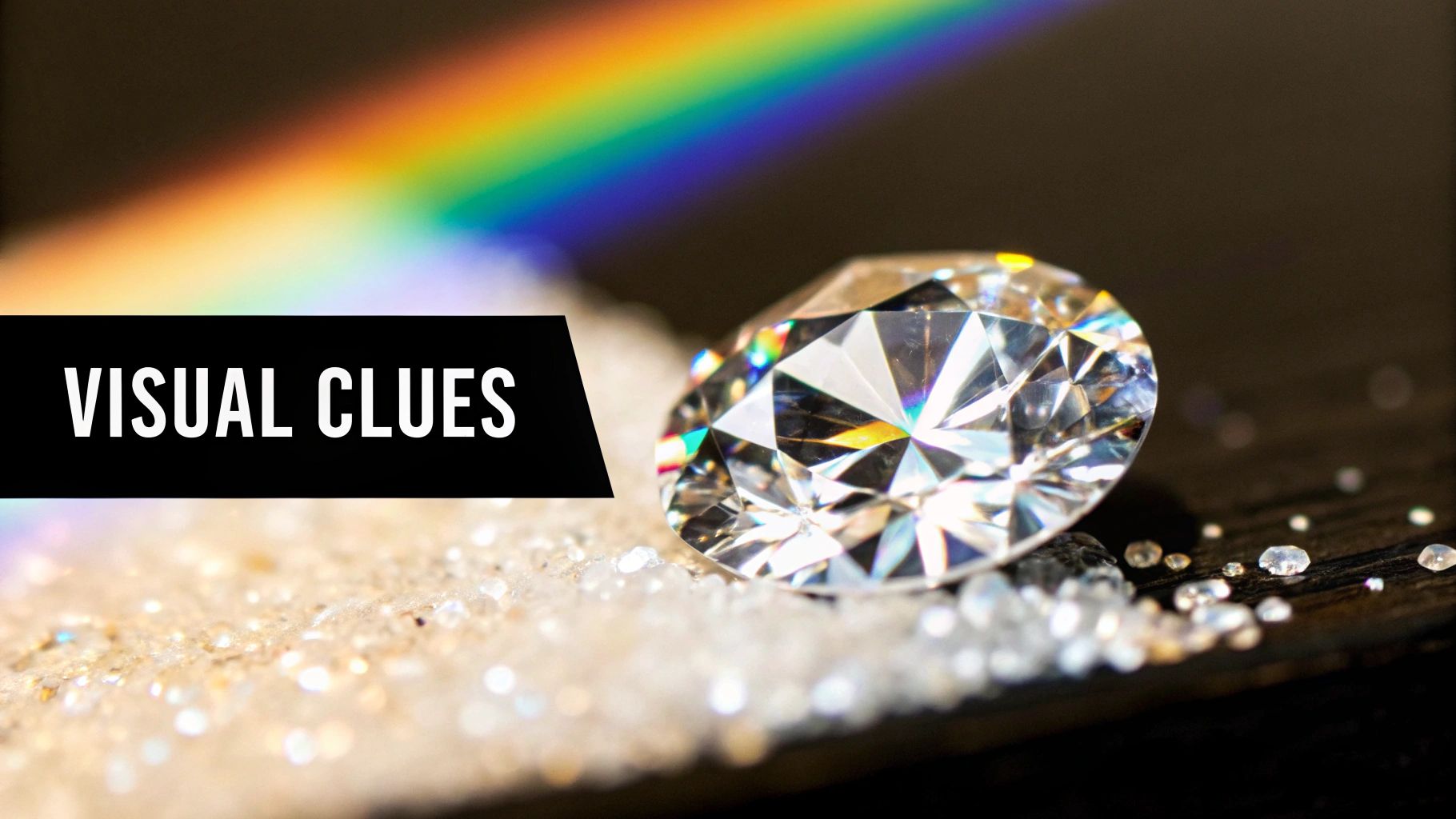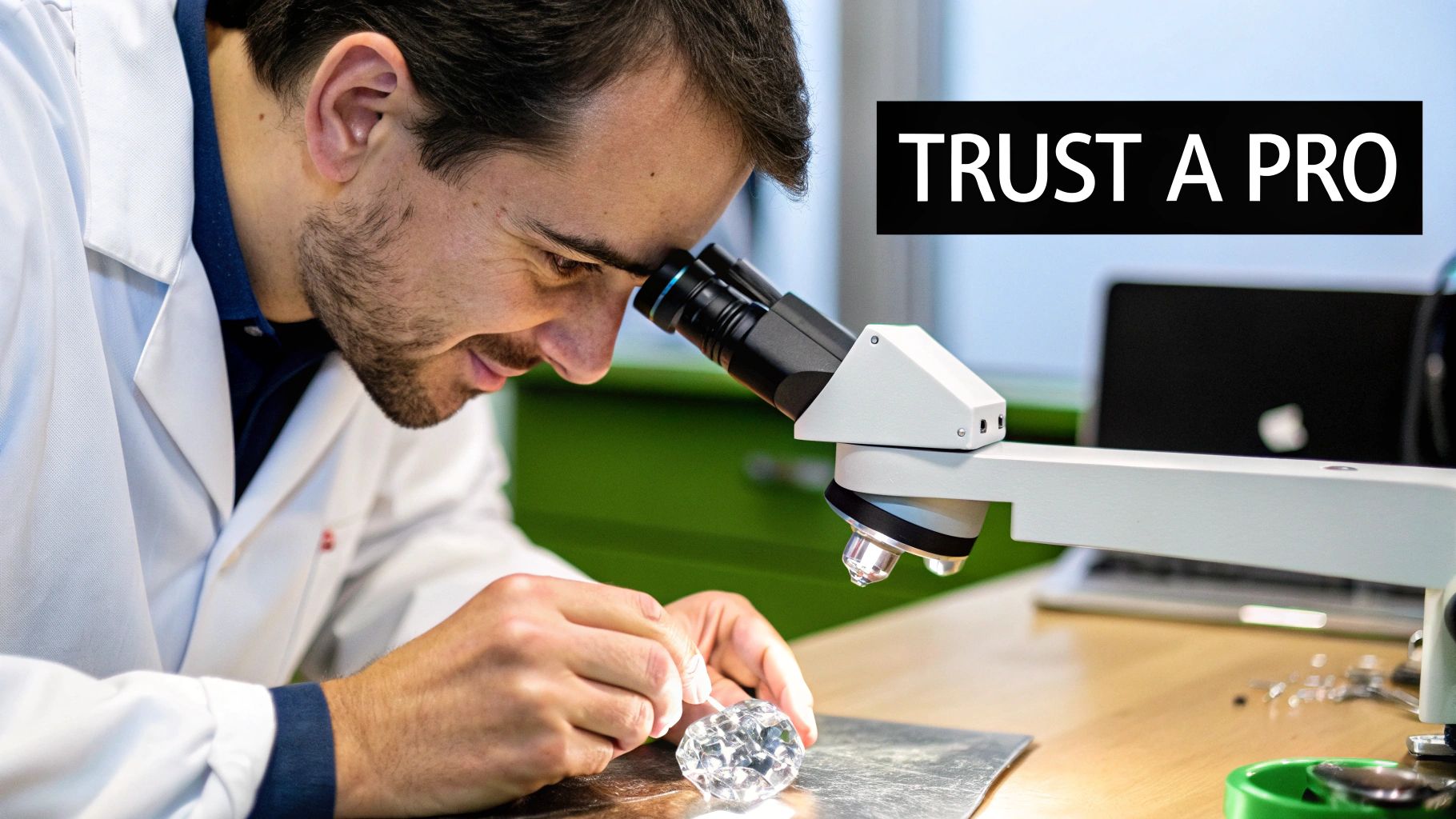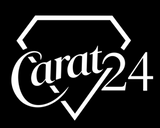Got a piece of jewelry you're curious about? The quickest way to get an initial read on a diamond is the Fog Test. It’s incredibly simple: just breathe on the stone like you would a mirror. If it’s a real diamond, the fog will clear up almost instantly. Why? Because real diamonds are incredible heat conductors and disperse the warmth from your breath in a flash.
Quick At-Home Tests for Your Diamond
Before you even think about getting a professional opinion, there are a few surprisingly effective tests you can run with things you already have around the house. These aren't going to give you a lab-certified answer, of course, but they're a fantastic first step to separate the real deal from a convincing fake.
Think of these as your first line of defense. They test a diamond's unique physical properties—like its density and the way it handles light—without needing any fancy equipment.
Simple Tests You Can Do Right Now
The Fog Test is a classic, but there are a couple of others you should try to get a more complete picture. Each one checks a different characteristic of your stone.
-
The Water Test: This one’s all about density. Find a glass of water and gently drop your loose stone in. A genuine diamond is incredibly dense, so it will sink straight to the bottom without hesitation. Many fakes, like glass or quartz, are less dense and might float, hover, or sink slowly.
-
The Dot Test: This test is a great way to see how the stone refracts light. Just draw a small, dark dot on a piece of white paper. Place your loose stone, flat-side down, directly over the dot. Now, look through the pointed top of the diamond. If it's real, its complex refraction will bend the light so much that you won't be able to see the dot. If you can clearly see the dot or even a circular reflection of it, you're likely looking at a fake.
A quick word of warning: You might have heard of the "scratch test," where a diamond is used to scratch glass. Please, don't do this. While a real diamond can scratch glass, so can many common fakes like moissanite. You risk damaging your stone, the glass, or both for a completely unreliable result.
While you're checking out the stone, don't forget to look at its setting. The metal can tell you a lot. Our guide on how to tell real gold from fake can help you inspect the band or mounting for clues.
At-Home Diamond Test Quick Reference
To make it easier, here's a quick summary of the simple tests you can perform at home. This table breaks down what each test checks for and what you should expect to see with both real and fake diamonds.
| Test Name | What It Checks | Real Diamond Result | Fake Diamond Result |
|---|---|---|---|
| Fog Test | Thermal Conductivity | Fog clears almost instantly | Fog lingers for several seconds |
| Water Test | Density | Sinks immediately to the bottom | Floats, hovers, or sinks slowly |
| Dot Test | Light Refraction | The dot is not visible through the stone | The dot is clearly visible or distorted |
Remember, these home-based methods are great for initial screening but aren't conclusive.
Ultimately, these tests are just preliminary checks. If you're planning on selling or just need a definitive answer, nothing beats a professional verification. When you're ready for that step, we make it easy. We offer free Xray Scanning and Gold Testing, providing you with a hassle-free offer and the highest payout in Boise. We even Price Matching, ensuring you get the absolute best value without any risk.
Decoding a Diamond's Visual Clues

While the at-home tests are a solid first step, nothing beats a well-trained eye. You can learn a lot just by looking at a stone—if you know what to look for. Modern fakes have gotten incredibly good, so just checking for a bit of sparkle isn't enough anymore. You need to understand how a real diamond truly handles light.
A genuine diamond’s signature sparkle is a delicate dance between two things: brilliance and fire.
Brilliance is that crisp, white light that seems to shoot back out from the stone. Fire is the colorful flashes of light, like a tiny rainbow, that you see when the diamond moves. A real diamond has a beautiful balance of both.
Now, many fakes—especially cubic zirconia—tend to overdo it on the fire. They throw off a wild, almost disco-ball rainbow effect that, while pretty, is a dead giveaway. A real diamond’s sparkle is intense but sharp and distinct, not just a chaotic mess of color.
Inspect the Setting and Mount
Don't just look at the stone; the metal holding it tells a story, too. Think about it: a truly valuable diamond isn't going to be set in cheap metal. It’s almost always paired with precious metals that reflect its worth. A quick look inside the ring's band can give you some major clues.
Grab a magnifying glass if you have one and look for the hallmarks or stamps that certify the metal's purity. You’re looking for markings like:
- 10K, 14K, or 18K: These indicate the karat of the gold.
- 750 or 585: These are the European equivalents for 18K and 14K gold.
- PT or Plat: This stamp designates platinum, a premium and durable choice for settings.
If you find a "C.Z." stamp or, even more telling, no markings at all, it’s a strong sign the stone isn't a natural diamond.
When you're still not sure about the stone or its setting, it’s always best to bring it to an expert. For locals, you can save the hassle and sell locally for more than online shipments. Our Gold and Jewelry Buying service offers the highest payout in Boise, and we even have a Price Matching guarantee.
If you’re ready to get a definitive answer, you can learn about our free Xray Scanning and Gold Testing process in our detailed guide to jewelry authentication services. This service will give you absolute certainty about what you own, along with a hassle-free offer.
The Challenge of Identifying Lab-Grown Diamonds
Telling a natural diamond from a convincing fake like cubic zirconia is one thing, but lab-grown diamonds (LGDs) are a whole different ballgame. These stones throw a massive wrench into traditional testing because, on a molecular level, they are real diamonds. They have the exact same chemical makeup and physical properties as their earth-mined cousins.
What does that mean for you? It means all those handy at-home tests we've discussed—from the fog test to the water test—will pass with flying colors. Even many basic jeweler's tools that test for thermal conductivity can't spot the difference.
This isn't a niche problem, either. It's becoming more common every single day.
By the early 2020s, LGDs already made up roughly 7–10% of the entire global diamond market, and production is still climbing by 15–20% every year. This explosive growth makes accurate identification more urgent than ever. You can dig deeper into why modern tools are struggling to keep up with this diamond identification challenge.
Why Professional Tools Are Necessary
So, if they're identical in almost every way, how can anyone possibly tell them apart? The secret is hidden in how they're made.
Lab diamonds are typically created using one of two methods:
- High Pressure/High Temperature (HPHT): This process essentially mimics nature, using immense pressure and heat to grow a diamond crystal.
- Chemical Vapor Deposition (CVD): This technique "grows" a diamond layer by painstaking layer using a carbon gas mixture.
While the end result is a diamond, each method leaves behind microscopic signatures and unique growth patterns that are completely invisible to the naked eye. These markers can only be found with highly advanced gemological equipment.
This distinction is critical because it directly impacts a diamond’s history, rarity, and resale value. While they might be chemically the same, the market values earth-mined and lab-created diamonds very differently.
For anyone involved in Gold and Jewelry Buying, knowing a diamond's true origin is non-negotiable. If you'd rather save the hassle and sell locally for more than online shipments, getting an expert verification is the only way to go.
We offer free Xray Scanning and Gold Testing to give you straightforward, hassle-free offers and the highest payout in Boise, backed by our Price Matching guarantee.
When to Trust a Professional Gemologist

Those at-home tests we've talked about are great for a first pass, but they have their limits. When you're dealing with a significant investment or a cherished family heirloom, you need absolute certainty. The simple truth is that home testing can't reliably distinguish a natural diamond from many of today's sophisticated lab-grown stones or treated gems.
That’s where the experts come in. A certified gemologist has access to specialized equipment that goes far beyond a simple thermal probe. They use a combination of high-tech tools to get a definitive answer:
- Thermal Probes: These are a starting point, detecting how a stone conducts heat almost instantly.
- Raman Spectroscopy: This advanced technique reveals a signature peak at 1332 cm⁻¹, a fingerprint unique to natural diamonds.
- High-Powered Microscopes: A trained eye can spot tell-tale growth patterns and tiny inclusions that give away a stone's origin.
- Spectrometers: By analyzing how light behaves as it passes through the stone, these tools provide conclusive data.
This isn't just about using one tool; it's about a comprehensive process in a controlled lab environment. This is how you get an answer you can bank on.
What to Expect During an Evaluation
So, what happens when you bring your stone in? The process usually starts with a detailed visual inspection under a loupe or microscope. A professional is looking for subtle clues—growth patterns, treatments, or inclusions—that are completely invisible to the naked eye.
Next, they'll likely use thermal probes for a basic conductivity check. For a deeper dive, especially in advanced labs, they'll turn to powerful tools like Raman spectroscopy. This technology, first introduced in the late 20th century, is a game-changer. It looks for that sharp peak at 1332 cm⁻¹—the undeniable signature of a natural diamond, which is absent in most fakes. You can learn more about how this works from the experts at Ocean Optics.
“Only a professional gemologist can deliver the absolute certainty you need when insuring or selling precious stones.”
Whether you're looking to insure, sell, or pass down your diamond, a gemologist's report provides the scientific proof you need to back its value. At Carat 24, we specialize in Gold and Jewelry Buying, offering instant, hassle-free offers and completely transparent valuations with free Xray Scanning and Gold Testing.
We stand by our process with a commitment to giving you the highest payout in Boise, and we even offer Price Matching to ensure you get fair value. Forget the risk and hassle of mailing your valuables away. Save the hassle and sell locally for more than online shipments.
To learn more about the formal appraisal process, check out our guide on finding a jewelry appraisal near me.
Get Free Expert Verification in Boise
After you've played detective with at-home tests, the only way to be 100% sure is to have a professional take a look. If you happen to be in the Boise area, you can skip the guesswork entirely. We offer a fast, professional evaluation for your diamonds and jewelry—and it's completely free.
Why deal with the stress and risk of shipping your valuables off to some faceless online buyer? Come see us instead. You'll avoid the hassle and often walk away with more money than those mail-in services promise. Our experts use state-of-the-art Xray Scanning and Gold Testing equipment to verify everything right in front of you. No smoke and mirrors, just straightforward answers.
Our Hassle-Free Local Service
We built our entire process around transparency and trust. We're specialists in no-nonsense Gold and Jewelry Buying, and our main goal is to give you total peace of mind.
- No Obligation: We'll make you a straightforward, hassle-free offer. There’s absolutely no pressure to sell.
- Price Matching: We're serious about offering the highest payout in Boise, and we back that up with a Price Matching guarantee.
- Immediate Payment: Forget waiting for a check in the mail. With us, you get paid right on the spot.
Getting an expert opinion isn't just about identifying a stone; it's about understanding its true value without any stress. We provide the tools and expertise to give you that confidence.
Choosing a local expert means a secure, immediate, and profitable experience. To get a better handle on maximizing your return, check out our guide on the best place to sell diamonds for some valuable insights.
Common Questions About Diamond Testing
Even after running a few at-home tests, you might still have some lingering questions. That's completely normal. Let's tackle some of the most common things people ask, clearing up the confusion so you can feel confident about your jewelry's authenticity and what it's really worth.
One of the first things people wonder is whether a real diamond can have flaws. The answer is a big yes. In fact, most natural diamonds have tiny internal characteristics called inclusions. Think of them as unique birthmarks. Perfectly flawless diamonds are incredibly rare and command a premium price, so seeing minor imperfections is often a good sign you're looking at a genuine, earth-mined stone.
Can a Diamond Chip or Break?
This is another great question. We all hear that diamonds are the hardest natural substance on Earth, and it's true—they rank a perfect 10 on the Mohs scale. But "hardest" doesn't mean "indestructible."
A sharp, well-placed impact can absolutely cause a diamond to chip or even fracture. This is why it's so important to have your jewelry handled by professionals who know how to work with these stones without causing damage.
Knowing a diamond is real is just the first piece of the puzzle. Understanding its condition and actual market value is just as critical, especially if you're thinking about selling it.
If selling is on your mind, you'll want to get a sense of what your diamond might bring. To see how things like cut, color, and condition factor into the final price, check out our guide on using a diamond resale value calculator. Arming yourself with this knowledge helps you make a much more informed decision when you get an offer.
Ultimately, nothing beats a professional, hands-on evaluation. It’s the only way to erase all doubt and get total clarity on both authenticity and value.
At Carat 24 - Trusted Gold Experts, we make the process simple. We specialize in Gold and Jewelry Buying and offer free Xray Scanning and Gold Testing to give you definitive answers and hassle-free offers with the highest payout in Boise—backed by our Price Matching guarantee. Save the hassle and sell locally for more than online shipments.
Find out more at https://carat24boise.com.


